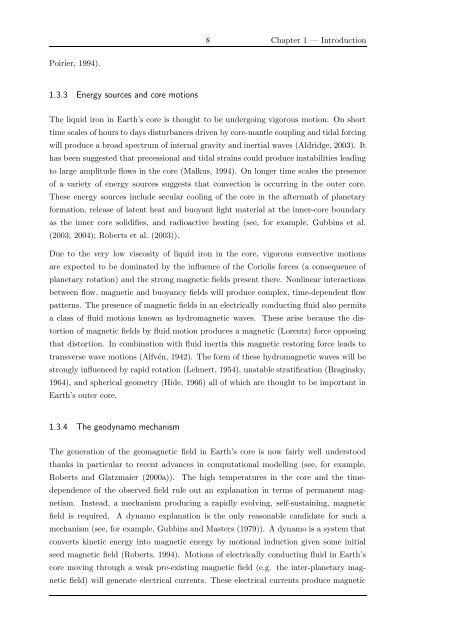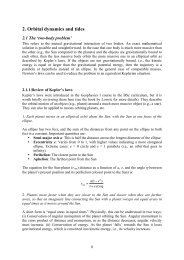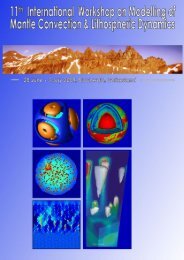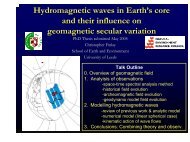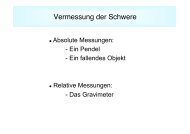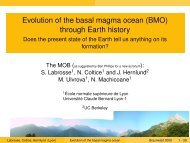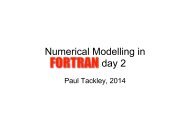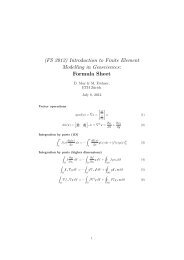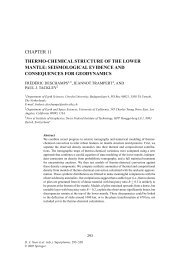Hydromagnetic waves in Earth's core and their influence on ...
Hydromagnetic waves in Earth's core and their influence on ...
Hydromagnetic waves in Earth's core and their influence on ...
You also want an ePaper? Increase the reach of your titles
YUMPU automatically turns print PDFs into web optimized ePapers that Google loves.
8 Chapter 1 — Introducti<strong>on</strong>Poirier, 1994).1.3.3 Energy sources <str<strong>on</strong>g>and</str<strong>on</strong>g> <str<strong>on</strong>g>core</str<strong>on</strong>g> moti<strong>on</strong>sThe liquid ir<strong>on</strong> <str<strong>on</strong>g>in</str<strong>on</strong>g> Earth’s <str<strong>on</strong>g>core</str<strong>on</strong>g> is thought to be undergo<str<strong>on</strong>g>in</str<strong>on</strong>g>g vigorous moti<strong>on</strong>. On shorttime scales of hours to days disturbances driven by <str<strong>on</strong>g>core</str<strong>on</strong>g>-mantle coupl<str<strong>on</strong>g>in</str<strong>on</strong>g>g <str<strong>on</strong>g>and</str<strong>on</strong>g> tidal forc<str<strong>on</strong>g>in</str<strong>on</strong>g>gwill produce a broad spectrum of <str<strong>on</strong>g>in</str<strong>on</strong>g>ternal gravity <str<strong>on</strong>g>and</str<strong>on</strong>g> <str<strong>on</strong>g>in</str<strong>on</strong>g>ertial <str<strong>on</strong>g>waves</str<strong>on</strong>g> (Aldridge, 2003). Ithas been suggested that precessi<strong>on</strong>al <str<strong>on</strong>g>and</str<strong>on</strong>g> tidal stra<str<strong>on</strong>g>in</str<strong>on</strong>g>s could produce <str<strong>on</strong>g>in</str<strong>on</strong>g>stabilities lead<str<strong>on</strong>g>in</str<strong>on</strong>g>gto large amplitude flows <str<strong>on</strong>g>in</str<strong>on</strong>g> the <str<strong>on</strong>g>core</str<strong>on</strong>g> (Malkus, 1994). On l<strong>on</strong>ger time scales the presenceof a variety of energy sources suggests that c<strong>on</strong>vecti<strong>on</strong> is occurr<str<strong>on</strong>g>in</str<strong>on</strong>g>g <str<strong>on</strong>g>in</str<strong>on</strong>g> the outer <str<strong>on</strong>g>core</str<strong>on</strong>g>.These energy sources <str<strong>on</strong>g>in</str<strong>on</strong>g>clude secular cool<str<strong>on</strong>g>in</str<strong>on</strong>g>g of the <str<strong>on</strong>g>core</str<strong>on</strong>g> <str<strong>on</strong>g>in</str<strong>on</strong>g> the aftermath of planetaryformati<strong>on</strong>, release of latent heat <str<strong>on</strong>g>and</str<strong>on</strong>g> buoyant light material at the <str<strong>on</strong>g>in</str<strong>on</strong>g>ner-<str<strong>on</strong>g>core</str<strong>on</strong>g> boundaryas the <str<strong>on</strong>g>in</str<strong>on</strong>g>ner <str<strong>on</strong>g>core</str<strong>on</strong>g> solidifies, <str<strong>on</strong>g>and</str<strong>on</strong>g> radioactive heat<str<strong>on</strong>g>in</str<strong>on</strong>g>g (see, for example, Gubb<str<strong>on</strong>g>in</str<strong>on</strong>g>s et al.(2003; 2004); Roberts et al. (2003)).Due to the very low viscosity of liquid ir<strong>on</strong> <str<strong>on</strong>g>in</str<strong>on</strong>g> the <str<strong>on</strong>g>core</str<strong>on</strong>g>, vigorous c<strong>on</strong>vective moti<strong>on</strong>sare expected to be dom<str<strong>on</strong>g>in</str<strong>on</strong>g>ated by the <str<strong>on</strong>g>in</str<strong>on</strong>g>fluence of the Coriolis forces (a c<strong>on</strong>sequence ofplanetary rotati<strong>on</strong>) <str<strong>on</strong>g>and</str<strong>on</strong>g> the str<strong>on</strong>g magnetic fields present there. N<strong>on</strong>l<str<strong>on</strong>g>in</str<strong>on</strong>g>ear <str<strong>on</strong>g>in</str<strong>on</strong>g>teracti<strong>on</strong>sbetween flow, magnetic <str<strong>on</strong>g>and</str<strong>on</strong>g> buoyancy fields will produce complex, time-dependent flowpatterns. The presence of magnetic fields <str<strong>on</strong>g>in</str<strong>on</strong>g> an electrically c<strong>on</strong>duct<str<strong>on</strong>g>in</str<strong>on</strong>g>g fluid also permitsa class of fluid moti<strong>on</strong>s known as hydromagnetic <str<strong>on</strong>g>waves</str<strong>on</strong>g>. These arise because the distorti<strong>on</strong>of magnetic fields by fluid moti<strong>on</strong> produces a magnetic (Lorentz) force oppos<str<strong>on</strong>g>in</str<strong>on</strong>g>gthat distorti<strong>on</strong>. In comb<str<strong>on</strong>g>in</str<strong>on</strong>g>ati<strong>on</strong> with fluid <str<strong>on</strong>g>in</str<strong>on</strong>g>ertia this magnetic restor<str<strong>on</strong>g>in</str<strong>on</strong>g>g force leads totransverse wave moti<strong>on</strong>s (Alfvén, 1942). The form of these hydromagnetic <str<strong>on</strong>g>waves</str<strong>on</strong>g> will bestr<strong>on</strong>gly <str<strong>on</strong>g>in</str<strong>on</strong>g>fluenced by rapid rotati<strong>on</strong> (Lehnert, 1954), unstable stratificati<strong>on</strong> (Brag<str<strong>on</strong>g>in</str<strong>on</strong>g>sky,1964), <str<strong>on</strong>g>and</str<strong>on</strong>g> spherical geometry (Hide, 1966) all of which are thought to be important <str<strong>on</strong>g>in</str<strong>on</strong>g>Earth’s outer <str<strong>on</strong>g>core</str<strong>on</strong>g>.1.3.4 The geodynamo mechanismThe generati<strong>on</strong> of the geomagnetic field <str<strong>on</strong>g>in</str<strong>on</strong>g> Earth’s <str<strong>on</strong>g>core</str<strong>on</strong>g> is now fairly well understoodthanks <str<strong>on</strong>g>in</str<strong>on</strong>g> particular to recent advances <str<strong>on</strong>g>in</str<strong>on</strong>g> computati<strong>on</strong>al modell<str<strong>on</strong>g>in</str<strong>on</strong>g>g (see, for example,Roberts <str<strong>on</strong>g>and</str<strong>on</strong>g> Glatzmaier (2000a)). The high temperatures <str<strong>on</strong>g>in</str<strong>on</strong>g> the <str<strong>on</strong>g>core</str<strong>on</strong>g> <str<strong>on</strong>g>and</str<strong>on</strong>g> the timedependenceof the observed field rule out an explanati<strong>on</strong> <str<strong>on</strong>g>in</str<strong>on</strong>g> terms of permanent magnetism.Instead, a mechanism produc<str<strong>on</strong>g>in</str<strong>on</strong>g>g a rapidly evolv<str<strong>on</strong>g>in</str<strong>on</strong>g>g, self-susta<str<strong>on</strong>g>in</str<strong>on</strong>g><str<strong>on</strong>g>in</str<strong>on</strong>g>g, magneticfield is required. A dynamo explanati<strong>on</strong> is the <strong>on</strong>ly reas<strong>on</strong>able c<str<strong>on</strong>g>and</str<strong>on</strong>g>idate for such amechanism (see, for example, Gubb<str<strong>on</strong>g>in</str<strong>on</strong>g>s <str<strong>on</strong>g>and</str<strong>on</strong>g> Masters (1979)). A dynamo is a system thatc<strong>on</strong>verts k<str<strong>on</strong>g>in</str<strong>on</strong>g>etic energy <str<strong>on</strong>g>in</str<strong>on</strong>g>to magnetic energy by moti<strong>on</strong>al <str<strong>on</strong>g>in</str<strong>on</strong>g>ducti<strong>on</strong> given some <str<strong>on</strong>g>in</str<strong>on</strong>g>itialseed magnetic field (Roberts, 1994). Moti<strong>on</strong>s of electrically c<strong>on</strong>duct<str<strong>on</strong>g>in</str<strong>on</strong>g>g fluid <str<strong>on</strong>g>in</str<strong>on</strong>g> Earth’s<str<strong>on</strong>g>core</str<strong>on</strong>g> mov<str<strong>on</strong>g>in</str<strong>on</strong>g>g through a weak pre-exist<str<strong>on</strong>g>in</str<strong>on</strong>g>g magnetic field (e.g. the <str<strong>on</strong>g>in</str<strong>on</strong>g>ter-planetary magneticfield) will generate electrical currents. These electrical currents produce magnetic


